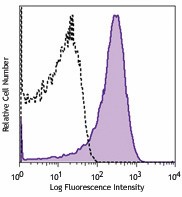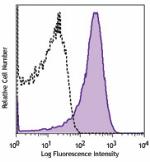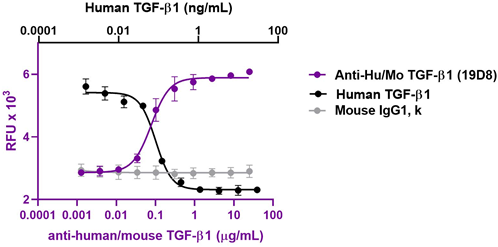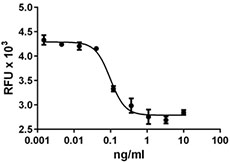- Clone
- TW7-28G11 (See other available formats)
- Regulatory Status
- RUO
- Other Names
- TGFB, TGFB1, DPD1, Latency Associated Peptide (LAP), TGF-β1, TGF-β
- Isotype
- Mouse IgG2b, κ
- Ave. Rating
- Submit a Review
- Product Citations
- publications

-

C57BL/6 mouse platelets were stained with LEAF™ purified anti-LAP (TGF-β1, clone TW7-28G11) (filled histogram) or LEAF™ purified mouse IgG2b, κ (open histogram), followed by anti-mouse IgG2b-PE.
| Cat # | Size | Price | Quantity Check Availability | Save | ||
|---|---|---|---|---|---|---|
| 146703 | 100 µg | 171 CHF | ||||
| 146704 | 1 mg | 644 CHF | ||||
Transforming growth factor beta (TGF-β) is a cytokine that has critical functions in the immune response by regulating Treg and Th17 cell differentiation. TGF-β is first synthesized as pro-TGF-β which is then cleaved by furin proprotein convertase in the Golgi apparatus to produce a latent TGF-β complex. This complex consists of non-covalently associated dimers of the N-terminal region of pro-TGF-β (latency-associated peptide, LAP) and C-terminal region of pro-TGF-β (mature TGF-β). The latent-TGF-β has been found on the membrane of activated Treg cells, immature dendritic cells, megakaryocytes, and platelets.
Product DetailsProduct Details
- Verified Reactivity
- Mouse, Human
- Antibody Type
- Monoclonal
- Host Species
- Mouse
- Immunogen
- Mouse Tgfb1'transduced P3U1 cells
- Formulation
- 0.2 µm filtered in phosphate-buffered solution, pH 7.2, containing no preservative.
- Endotoxin Level
- Less than 0.01 EU/µg of the protein (< 0.001 ng/µg of the protein) as determined by the LAL test.
- Preparation
- The Ultra-LEAF™ (Low Endotoxin, Azide-Free) antibody was purified by affinity chromatography.
- Concentration
- The antibody is bottled at the concentration indicated on the vial, typically between 2 mg/mL and 3 mg/mL. Older lots may have also been bottled at 1 mg/mL. To obtain lot-specific concentration and expiration, please enter the lot number in our Certificate of Analysis online tool.
- Storage & Handling
- The antibody solution should be stored undiluted between 2°C and 8°C. This Ultra-LEAF™ solution contains no preservative; handle under aseptic conditions.
- Application
-
FC - Quality tested
WB, IP, Neut - Reported in the literature, not verified in house - Recommended Usage
-
Each lot of this antibody is quality control tested by immunofluorescent staining with flow cytometric analysis. For flow cytometric staining, the suggested use of this reagent is ≤1.0 µg per million cells in 100 µl volume or 100 µl of whole blood. It is recommended that the reagent be titrated for optimal performance for each application.
- Application Notes
-
Several anti-LAP antibody clones have been compared and characterized for their LAP reactivity.2 TW7-28G11 recognizes conformation specific latent TGF-β complex (LAP + TGF-β) and pro-TGF-β1, but not free LAP or active TGF-β.
Additional reported applications (for relevant formats) include: Western blotting1, immunoprecipitation1, and neutralization2. TW7-28G11 is able to neutralize TGF-β activity. -
Application References
(PubMed link indicates BioLegend citation) -
- Oida T and Weiner HL. 2010. PloS ONE 5:e15523. (FC, IP, WB)
- Oida T and Weiner HL. 2011. PLoS ONE 6:e18365. (Neut)
- Product Citations
-
- RRID
-
AB_2562709 (BioLegend Cat. No. 146703)
AB_2562710 (BioLegend Cat. No. 146704)
Antigen Details
- Structure
- Dimers of latency-associated peptide non-covalently associated with dimers of mature TGF-β
- Distribution
- Many cell types, highly expressed on activated Treg cells and platelets
- Function
- TGF-β controls cell differentiation, tissue morphogenesis, cell growth, inflammation, matrix synthesis, apoptosis, and regulates immune response.
- Ligand/Receptor
- TGF-β receptors
- Cell Type
- Tregs, Platelets, Dendritic cells
- Biology Area
- Apoptosis/Tumor Suppressors/Cell Death, Cell Biology, Immunology, Signal Transduction
- Molecular Family
- Cytokines/Chemokines, Growth Factors
- Antigen References
-
1. Oida T and Weiner HL. 2010. PLoS One 5:e15523.
2. Tran DQ, et al. 2009. Proc. Natl. Acad. Sci. USA 106:13445.
3. Ochi H, et al. 2006. Nat. Med. 12:627.
4. Oida T, et al. 2003. J. Immunol. 170:2516.
5. Nakamura K, 2001. J. Exp. Med. 194:629.
6. Miyazono K, et al. 1993. Growth Factor 8:11. - Gene ID
- 21803 View all products for this Gene ID
- UniProt
- View information about LAP on UniProt.org
Related FAQs
- Do you guarantee that your antibodies are totally pathogen free?
-
BioLegend does not test for pathogens in-house aside from the GoInVivo™ product line. However, upon request, this can be tested on a custom basis with an outside, independent laboratory.
- Does BioLegend test each Ultra-LEAF™ antibody by functional assay?
-
No, BioLegend does not test Ultra-LEAF™ antibodies by functional assays unless otherwise indicated. Due to the possible complexities and variations of uses of biofunctional antibodies in different assays and because of the large product portfolio, BioLegend does not currently perform functional assays as a routine QC for the antibodies. However, we do provide references in which the antibodies were used for functional assays and we do perform QC to verify the specificity and quality of the antibody based on our strict specification criteria.
- Does BioLegend test each Ultra-LEAF™ antibody for potential pathogens?
-
No, BioLegend does not test for pathogens in-house unless otherwise indicated. However, we can recommend an outside vendor to perform this testing as needed.
- Have you tested this Ultra-LEAF™ antibody for in vivo or in vitro applications?
-
We don't test our antibodies for in vivo or in vitro applications unless otherwise indicated. Depending on the product, the TDS may describe literature supporting usage of a particular product for bioassay. It may be best to further consult the literature to find clone specific information.
Other Formats
View All LAP Reagents Request Custom Conjugation| Description | Clone | Applications |
|---|---|---|
| Ultra-LEAF™ Purified anti-mouse/human LAP (TGF-β1) | TW7-28G11 | FC,WB,IP,Neut |
Customers Also Purchased
Compare Data Across All Formats
This data display is provided for general comparisons between formats.
Your actual data may vary due to variations in samples, target cells, instruments and their settings, staining conditions, and other factors.
If you need assistance with selecting the best format contact our expert technical support team.
-
Ultra-LEAF™ Purified anti-mouse/human LAP (TGF-β1)

C57BL/6 mouse platelets were stained with LEAF™ purifi...
 Login / Register
Login / Register 












Follow Us